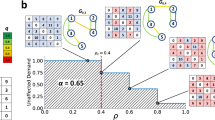Abstract
Studying the phase transition process from free flow to congested state in communication networks is one of the hot topics of dynamically complex systems, and many related theoretical and computational efforts have been made to improve traffic systems’ organization and load management. A criterion to measure the organization efficiency of the system is the formation process of a global traffic flow cluster from local small clusters in a communication network which can be evaluated by measuring the percolation threshold. While little attention has been paid to percolation in such studies, in this research, the traffic percolation threshold is defined based on the system nodes’ loads to examine the influences of the network structures, different routing strategies, and distributions of transmission capacities on the efficiency of the communication networks. Considering the obtained results, it was found any variation in the network structure and traffic control strategies that leads to a rather diverse load distribution among the system’s nodes can organize traffic loads more efficiently.
Graphical abstract

An agent-based model is employed finding modified approaches to better managing traffic loads, considering percolation transition analysis.







Similar content being viewed by others
Data availability statement
The data that support the findings of this study are available from the corresponding author upon reasonable request.
References
K. Nagel, M. Schreckenberg, J. Phys. I 2(12), 2221–2229 (1992)
M. Bando, K. Hasebe, A. Nakayama, A. Shibata, Y. Sugiyama, Phys. Rev. E 51(2), 1035 (1995)
B.S. Kerner, Phys. Rev. Lett. 81(17), 3797 (1998)
D. Helbing, B.A. Huberman, Nature 396(6713), 738–740 (1998)
M. Treiber, A. Hennecke, D. Helbing, Phys. Rev. E 62(2), 1805 (2000)
P. Echenique, J. Gómez-Gardenes, Y. Moreno, Europhys. Lett. 71(2), 325 (2005)
B.S. Kerner, Phys. World 12(8), 25 (1999)
D. Chowdhury, L. Santen, A. Schadschneider, Phys. Rep. 329(4–6), 199–329 (2000)
D. Helbing, Rev. Mod. Phys. 73(4), 1067 (2001)
Z. Liu, M.B. Hu, R. Jiang, W.X. Wang, Q.S. Wu, Phys. Rev. E 76(3), 037101 (2007)
A. Zeng, W. Liu, Phys. Rev. E 85(6), 066130 (2012)
J. Wu, Z.Y. Gao, H.J. Sun, Physica A 378(2), 505–511 (2007)
C. Shi, Y. Peng, Y. Zhuo, J. Tang, K. Long, Phys. Scr. 85(3), 035803 (2012)
X. Ling, M.B. Hu, R. Jiang, Q.S. Wu, Phys. Rev. E 81(1), 016113 (2010)
T. Fei, Y. Xia, Physica A 392(18), 4146–4153 (2013)
Z. Xi, Z. Zhou, D. Cheng, PLoS One 12(2), 0172035 (2017)
O. Kinouchi, M. Copelli, Nat. Phys. 2(5), 348–351 (2006)
T. Mora, W. Bialek, J. Stat. Phys. 144, 268–302 (2011)
J. Hidalgo, J. Grilli, S. Suweis, M.A. Munoz, J.R. Banavar, A. Maritan, Proc. Natl. Acad. Sci. 111(28), 10095–10100 (2014)
C. Dabrowski, Comput. Sci. Rev. 18, 10–45 (2015)
F. Aghaei, A. Lohrasebi, Eur. Phys. J. Plus 136(11), 1111 (2021)
S. Ebrahimabadi, A. Hosseiny, J. Fan, A.A. Saberi, Phys. Rev. E 108, 054311 (2023)
D. Stauffer, A. Aharony, Introduction to percolation theory (Second Edn), CRC Press (2018). https://doi.org/10.1201/9781315274386
M. Sahimi, Applications of percolation theory (Second Edition), Springer (2023). https://doi.org/10.1007/978-3-031-20386-2
D. Li, B. Fu, Y. Wang, G. Lu, Y. Berezin, H.E. Stanley, S. Havlin, Proc. Natl. Acad. Sci. 112(3), 669–672 (2015)
A.H. Shirazi, A.A. Saberi, A. Hosseiny, E. Amirzadeh, P. Toranj Simin, Sci. Rep. 7, 15855 (2017)
F. Wang, D. Li, X. Xu, R. Wu, S. Havlin, Europhys. Lett. 112(3), 38001 (2015)
S. Li, H. Yang, M. Li, J. Dai, P. Wang, Sustainability 15(16), 12608 (2023)
D. De Martino, L. Dall’Asta, G. Bianconi, M. Marsili, Phys. Rev. E 79(1), 015101 (2009)
D.J. Watts, S.H. Strogatz, Nature 393(6684), 440–442 (1998)
A.L. Barabási, R. Albert, Science 286(5439), 509–512 (1999)
W.X. Wang, B.H. Wang, C.Y. Yin, Y.B. Xie, T. Zhou, Phys. Rev. E 73(2), 026111 (2006)
B. Danila, Y. Yu, S. Earl, J.A. Marsh, Z. Toroczkai, K.E. Bassler, Phys. Rev. E 74(4), 046114 (2006)
W.X. Wang, C.Y. Yin, G. Yan, B.H. Wang, Phys. Rev. E 74(1), 016101 (2006)
L. Page, S. Brin, R. Motwani, T. Winograd (1998) The PageRank Citation Ranking: Bringing Order to the Web. Technical Report SIDL-WP-1999-0120, Stanford Digital Library Technologies Project
G. Sabidussi, Psychometrika 31(4), 581–603 (1966)
M.A. Munoz, Rev. Mod. Phys. 9(3), 031001 (2018)
D. De Martino, L. Dall’Asta, G. Bianconi, M. Marsili, J. Stat. Mech.: Theory Exp. 08, P08023 (2009)
F. Santo, M. Boguñá, A. Flammini, F. Menczer, Approximating PageRank from in-degree, in W. Aiello, A. Broder, J. Janssen, E. Milios, editors. Algorithms and Models for the Web-Graph. WAW 2006. Lecture Notes in Computer Science, vol. 4936. Springer, Berlin (2008)
Funding
There is no significant financial support for this work.
Author information
Authors and Affiliations
Contributions
All authors contributed equally to the work.
Corresponding author
Ethics declarations
Conflict of interest
The authors declare that there is no conflict of interest. The authors declare that they have no known competing financial interests or personal relationships that could have appeared to influence the work reported in this paper.
Supplementary Information
Below is the link to the electronic supplementary material.
Rights and permissions
Springer Nature or its licensor (e.g. a society or other partner) holds exclusive rights to this article under a publishing agreement with the author(s) or other rightsholder(s); author self-archiving of the accepted manuscript version of this article is solely governed by the terms of such publishing agreement and applicable law.
About this article
Cite this article
Aghaei, F., Lohrasebi, A. Analysis of traffic in communication networks based on percolation transition. Eur. Phys. J. B 97, 17 (2024). https://doi.org/10.1140/epjb/s10051-024-00652-0
Received:
Accepted:
Published:
DOI: https://doi.org/10.1140/epjb/s10051-024-00652-0




